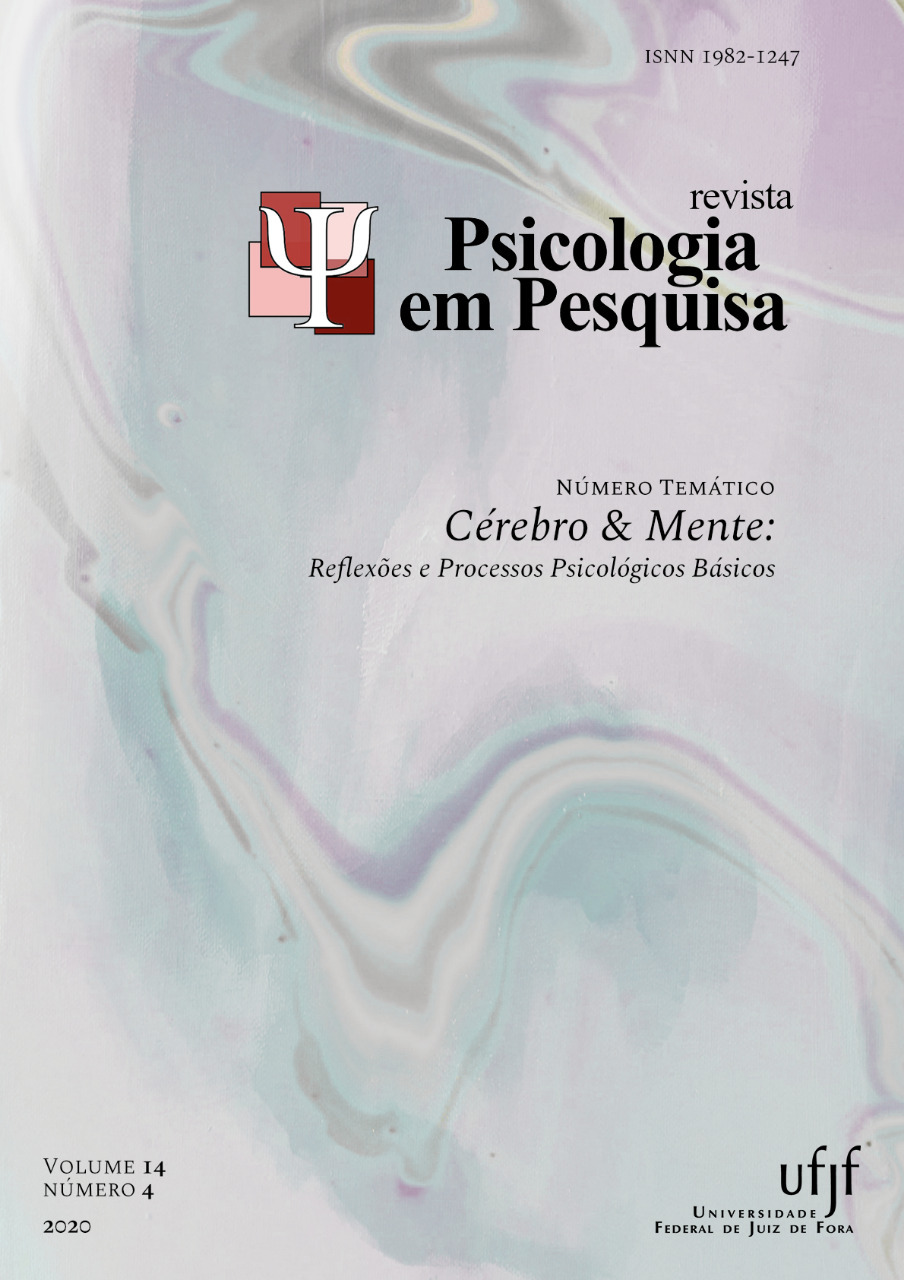Efeito Kuleshov: A Influência do Contexto Emocional no Processamento de Faces
DOI:
https://doi.org/10.34019/1982-1247.2020.v14.29122Resumo
Em 1920, Lev Vladimirovitch Kuleshov relatou que o contexto emocional quando justaposto à face neutra poderia afetar a percepção da face, tornando-a emocional. Na área do cinema este fenômeno foi denominado de efeito Kuleshov. A existência do efeito tem sido cientificamente questionada, e desde então, neurocientistas tentam validar o efeito Kuleshov. Neste artigo iremos sumarizar os diferentes modelos experimentais que têm sido utilizados na investigação do efeito Kuleshov e os resultados encontrados até o momento por meio do método científico; mais precisamente em pesquisas experimentais e da neurociência. Os resultados desses estudos mostram indícios do efeito Kuleshov a nível comportamental e de processamento neuronal, entretanto, nenhum estudo conseguiu comprová-lo.
Downloads
Referências
Baranowski, A. M., & Hecht, H. (2017). The Auditory Kuleshov Effect: Multisensory Integration in Movie Editing. Perception, 46(5), 624–631. https://doi.org/10.1177/0301006616682754
Barratt, D., Rédei, A. C., Innes-Ker, Å., & van de Weijer, J. (2016). Does the Kuleshov Effect Really Exist? Revisiting a Classic Film Experiment on Facial Expressions and Emotional Contexts. Perception, 45(8), 847–874. https://doi.org/10.1177/0301006616638595
Branigan, E. (1984). Point of View in the Cinema. Mouton de Gruyter.
Brothers, L. (1990). The neural basis of primate social communication. Motivation and Emotion, 14(2), 81–91. https://doi.org/10.1007/BF00991637
Calbi, M., Heimann, K., Barratt, D., Siri, F., Umiltà, M. A., & Gallese, V. (2017). How Context Influences Our Perception of Emotional Faces: A Behavioral Study on the Kuleshov Effect. Frontiers in Psychology, 8. https://doi.org/10.3389/fpsyg.2017.01684
Calbi, M., Siri, F., Heimann, K., Barratt, D., Gallese, V., Kolesnikov, A., & Umiltà, M. A. (2019). How context influences the interpretation of facial expressions: A source localization high-density EEG study on the “Kuleshov effect”. Scientific Reports, 9(1), 2107. https://doi.org/10.1038/s41598-018-37786-y
Giannetti, L., & Eyman, S. (2009). Flashback: A Brief Film History (6 edition). Boston, MA: Pearson Education/Allyn & Bacon.
Guo, K., & Shaw, H. (2015). Face in profile view reduces perceived facial expression intensity: An eye-tracking study. Acta Psychologica, 155, 19–28. https://doi.org/10.1016/j.actpsy.2014.12.001
Herring, D. R., Taylor, J. H., White, K. R., & Crites, S. L. Jr. (2011). Electrophysiological responses to evaluative priming: The LPP is sensitive to incongruity. 794–806. https://doi.org/10.1037/a0022804
Hietanen, J. K., & Astikainen, P. (2013). N170 response to facial expressions is modulated by the affective congruency between the emotional expression and preceding affective picture. Biological Psychology, 92(2), 114–124. https://doi.org/10.1016/j.biopsycho.2012.10.005
Leyda, J. (1983). Kino: A History of the Russian and Soviet Film (3 edition). Princeton, N.J: Princeton University Press.
MacKay, J. (2013). Built on a Lie: Propaganda, Pedagogy, and the Origins of the Kuleshov Effect. The Oxford Handbook of Propaganda Studies. https://doi.org/10.1093/oxfordhb/9780199764419.013.021
Mobbs, D., Weiskopf, N., Lau, H. C., Featherstone, E., Dolan, R. J., & Frith, C. D. (2006). The Kuleshov Effect: The influence of contextual framing on emotional attributions. Social cognitive and affective neuroscience, 1(2), 95–106. https://doi.org/10.1093/scan/nsl014
Neta, M., Davis, F. C., & Whalen, P. J. (2011). Valence resolution of facial expressions using an emotional oddball task. Emotion (Washington, D.C.), 11(6), 1425–1433. https://doi.org/10.1037/a0022993
Prince, S., & Hensley, W. E. (1992). The Kuleshov Effect: Recreating the Classic Experiment. Cinema Journal, 31(2), 59–75. https://doi.org/10.2307/1225144
Righart, R., & de Gelder, B. (2006). Context Influences Early Perceptual Analysis of Faces—An Electrophysiological Study. Cerebral Cortex, 16(9), 1249–1257. https://doi.org/10.1093/cercor/bhj066
Righart, R., & de Gelder, B. (2008). Rapid influence of emotional scenes on encoding of facial expressions: An ERP study. Social cognitive and affective neuroscience, 3(3), 270–278. https://doi.org/10.1093/scan/nsn021
Russell, J. A. (1980). A circumplex model of affect. Journal of Personality and Social Psychology, 39(6), 1161–1178. https://doi.org/10.1037/h0077714
Russell, J. E., & Fehr, B. W. (1987). Relativity in the Perception of Emotion in Facial Expressions. https://doi.org/10.1037/0096-3445.116.3.223
Schurgin, M. W., Nelson, J., Iida, S., Ohira, H., Chiao, J. Y., & Franconeri, S. L. (2014). Eye movements during emotion recognition in faces. Journal of Vision, 14(13), 14–14. https://doi.org/10.1167/14.13.14
Smith, A. P. R., Henson, R. N. A., Dolan, R. J., & Rugg, M. D. (2004). FMRI correlates of the episodic retrieval of emotional contexts. NeuroImage, 22(2), 868–878. https://doi.org/10.1016/j.neuroimage.2004.01.049
Smith, T. J. (2011). The Attentional Theory of Cinematic Continuity. Projections: The Journal for Movies and the Mind.
Smith, T. J., Levin, D., & Cutting, J. E. (2012). A Window on Reality: Perceiving Edited Moving Images. p. 107–113.
Vladimirovich Kuleshov, L., & Levaco, R. (1974). Kuleshov on Film: Writings by Lev Kuleshov. Berkeley and Los Angeles, California: Univ of California Pr.
Werheid, K., Alpay, G., Jentzsch, I., & Sommer, W. (2005). Priming emotional facial expressions as evidenced by event-related brain potentials. International Journal of Psychophysiology, 55(2), 209–219. https://doi.org/10.1016/j.ijpsycho.2004.07.006
Wieser, M. J., & Brosch, T. (2012). Faces in Context: A Review and Systematization of Contextual Influences on Affective Face Processing. Frontiers in Psychology, 3. https://doi.org/10.3389/fpsyg.2012.00471
Zhang, Q., Li, X., Gold, B. T., & Jiang, Y. (2010). Neural correlates of cross-domain affective priming. Brain Research, 1329, 142–151. https://doi.org/10.1016/j.brainres.2010.03.021















